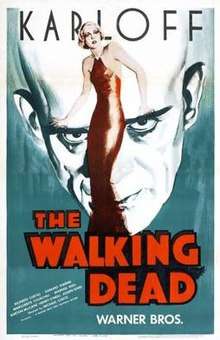The Walking Dead (1936 film)
The Walking Dead is a 1936 American horror film directed by Michael Curtiz and starring Boris Karloff, who plays a wrongly executed man who is restored to life by a scientist (Edmund Gwenn). The supporting cast features Ricardo Cortez, Marguerite Churchill and Barton MacLane. The film was distributed by Warner Bros.
| The Walking Dead | |
|---|---|
 | |
| Directed by | Michael Curtiz |
| Produced by | Jack L. Warner[1] |
| Screenplay by | [1] |
| Story by |
|
| Starring | |
| Cinematography | Hal Mohr[1] |
| Edited by | Tommy Prat[1] |
Production company | |
| Distributed by | Warner Bros. |
Release date |
|
Running time | 66 minutes[1] |
| Country | United States[2] |
| Budget | $217,000[3] |
| Box office | $300,000[3] |

Plot
John Ellman (Boris Karloff) has been framed for murder by a gang of racketeers. He is unfairly tried and despite the fact that his innocence has been proven, he is sent to the electric chair and executed. Dr. Evan Beaumont (Edmund Gwenn) retrieves his dead body and revives it, as part of his experiments to reanimate a dead body and discover what happens to the soul after death.
Dr. Beaumont's use of a mechanical heart to revive the patient foreshadows modern medicine's mechanical heart to keep patients alive during surgery. Although John Ellman has no direct knowledge of anyone wishing to frame him for the murder before he is executed, he gains an innate sense of knowing those who are responsible after he is revived. Ellman takes no direct action against his framers; however, he seeks them out, wishing to know why they had him killed. Each dies a horrible death, and in the end it is their own guilt that causes their deaths.
Confronting the last two villains, Ellman is shot. Having fulfilled his divine mission to bring about justice, he dies, just before he would have explained death and the afterlife to the curious Dr. Beaumont. Beaumont is warned not to continue his experiments, citing the Biblical Scripture, "For the LORD thy God is a jealous God (Deut. 6:15a)."
Cast
- Boris Karloff as John Ellman
- Ricardo Cortez as Mr. Nolan
- Edmund Gwenn as Dr. Evan Beaumont (Made up to resemble Lionel Atwill)
- Marguerite Churchill as Nancy
- Warren Hull as Jimmy
- Barton MacLane as Loder
- Henry O'Neill as District Attorney Werner
- Joe King as Judge Roger Shaw
- Addison Richards as Prison Warden
- Paul Harvey as Blackstone
- Robert Strange as Merritt
- Joe Sawyer as "Trigger" Smith
- Eddie Acuff as Betcha
- Kenneth Harlan as Stephen Martin
- Miki Morita as Sako, Loder's Butler
- Frank Darien as Cemetery Caretaker (uncredited)
Production
The Walking Dead's executive producer Hal Wallis wrote to the production supervisor Lou Edelmen on August 16, 1935 that he has sent him a six page outline for a film titled The Walking Dead .[4] The original story for the film was written by Ewart Adamson and Joseph Fields.[5] On November 1, director Michael Curtiz was sent the draft of the film.[4] A few days before shooting was scheduled, actor Boris Karloff voiced problems involving his character John Ellman.[6] These issues included Ellman's lack of speech which he felt was too close to his role in Frankenstein (1931), and Ellman's Tarzan-like agility which he felt would induce laughter.[6] Wallis brought in three more writers for the film.
In addition to Karloff's stunted dialogue, this film's resemblance to Universal's Frankenstein is most obvious when Edmund Gwenn's character revives Karloff; including the dramatic change in music, the pulsating lab equipment, off-kilter camera angles, and finally when Gwenn says, "He's alive".
The Walking Dead was filmed at Griffith Park, California and Warner Bros. Studios between November 23 and December 1935.[1]
Irving Rapper worked on the film. He called it "a bad story" but enjoyed working with Curtiz.[7]
Release
The Walking Dead premiered on February 29, 1936.[1] Writing in the March 4, 1936 issue of Variety, the reviewer "Odec" said that the film would provide "limited satisfaction" for film patrons with "a yen for shockers." The reviewer wrote that "The director and the supporting cast try hard to give some semblance of credibility to the trite and pseudo-scientific vaporings of the writers, but the best they can produce is something that moves swiftly enough but contains little of sustained interest." Further, "Odec" predicted that "Karloff will have to sold on past performances" as The Walking Dead "lets him down badly."[8]
United Artists Associates syndicated the film to local US television stations as part of its 58-film package, "Science Fiction-Horror-Monster Features." The package became available on May 15, 1963.[9]
References
- Mank, 2001. p.184
- "The Walking Dead". BFI Film & TV Database. British Film Institute. Retrieved November 28, 2012.
- Stephen Jacobs, Boris Karloff: More Than a Monster, Tomohawk Press 2011 p 192-193
- Mank, 2001. p.188
- Mank, 2001. p.189
- Mank, 2001. p.190
- Higham, Charles; Greenberg, Joel (1971). The celluloid muse; Hollywood directors speak. Regnery. p. 226.
- Willis, ed., Donald (1985). Variety's Complete Science Fiction Reviews. NY: Garland Publishing Inc. pp. 48–49. ISBN 0824087127.CS1 maint: extra text: authors list (link)
- Heffernan, Kevin (2004). Ghouls, Gimmicks, and Gold: Horror Films and the American Movie Business, 1953-1968. Durham NC: Duke University Press. pp. 258–259. ISBN 0822332159.
Bibliography
- Mank, Gregory William (2001). Hollywood Cauldron: Thirteen Horror Films from the Genre's Golden Age. McFarland. ISBN 0-7864-1112-0.
External links
| Wikiquote has quotations related to: The Walking Dead (1936 film) |